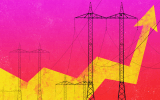


Next month’s government roundtable seeks a better future for all Australians. And, indeed, our society has well-known and well-documented lists of policies that can reliably deliver on that desired outcome.
To illustrate, the Australian Council of Learned Academies (ACOLA) has estimated if all the individual policies proposed by major analysts and agencies in 2015 had been implemented then, for both structural reform AND investing in our future, consumption per head would have been some $7700 better off today, 10 years later.
We did not seize this opportunity and instead failed to rise above conventional party and interest group zero-sum politics. Yet good government could have taken the people on such a journey.
Public attitude analysis for ACOLA in 2015 demonstrated that a clear majority of the population was supportive. Only 23 per cent were resistant.
The breakthrough needed was leadership and communication. This had been a key for the preceding Hawke-Keating-Howard reform era.
Roundtables back then were one of the vehicles for such communication, so it is good that they, at least, have returned to assist with consensus building.
Many of the policies needed are again well-known and well-documented. But acceleration can be added through new policy ideas as well.
An Australian way forward
For such acceleration, some further use of the distinctive Australian policy innovation of income contingent loans could add extra value to the common available policy reform packages under consideration.
Contingent loans could especially be applied in two key fields where known problems continue to exist: Boosting business research and development and assisting businesses to better manage disasters.
The use of contingent loans for these will ensure repayment with innovation success and with economic recovery and hence budget sustainability.
This approach would be distinctively Australian as the contingent loan system was pioneered in Australia through HECS in higher education funding.
- Compared to grants or tax concessions, this can ensure a lot more money is available at potentially no net cost to the taxpayer.
- Compared to conventional loans it does not oppress the lives of those unable to repay the loan.
Further:
- Such loans can be efficiently and effectively administered through the BAS tax system.
- Extensive research and modelling exists to guide introduction of these schemes.
Alternative schemes in these areas have either not worked well and/or they have been exceedingly expensive, such as research and development tax concessions and JobKeeper.
Enhancing productivity through R&D
The deficiencies in Australian R&D activity are well-documented e.g. Australia’s gross domestic product share is now only 60 per cent of even the OECD mean ratio.
Accordingly, assistance is suggested via a revenue-contingent loan (RCL) for start-up companies that repay this initial outlay to the government when financially viable.
This will be particularly important for traversing the cashflow deficit stage for long pay-off innovation known as the “valley of death”.
As well, the RCL is repaid at a low percentage of the company’s annual revenue and would be based on revenue information that is simply and legally required through the quarterly Business Activity Statement. The scheme could well extend beyond start-ups.
Successful start-up companies could be required to repay more than the initial outlay to ensure that the scheme is financially neutral for the government.
There could be an initial outlay by government for several years but then no drain on the public purse. Careful selection should still be required to assess potential in the companies, and this could operate in conjunction with commercial advice and research scrutiny from universities.
The possibility of false bankruptcies is also addressed through this selection and through mechanisms such as making a valid part of the debt obligation still to be shared by the owners of the enterprise.
Resilience for disasters
In recent times Australia has faced major health and economic crises such as the 2020 bushfires, the 2020 Covid pandemic, and the 2022 floods:
- In the 2019-2020 bushfire season, 18 million hectares and 2600 homes were destroyed.
- The level of GDP was estimated to have suffered a cumulative loss from the 2020 pandemic of $158 billion compared to its pre-pandemic trajectory.
- The 2022 eastern Australian floods are calculated as the fourth most costly global disaster of that year.
The top task always is to prevent and fight such disasters. But more attention is needed, and in advance, on recovery. Recovery is often lost sight of after the headlines die away or ad hoc fixes are adopted.
Contingent loans to affected businesses can prevent economic and social collapse for the affected individuals and communities and especially support those most adversely affected, and yet without necessarily a full debt burden for the whole community into the future.
Partnership would be crucial here too, as with R&D – such as with arrangements of joint bank and government lending, with the government providing revenue-contingent loans alongside commercial bank loans.
The government loan could even repay the bank loan in the very short-term until business reopens and recovers, with monitoring through the BAS system. The system can be complementary to grant schemes for extreme disaster.
The key here is to ensure that the schemes are fully in place and ready to be administered prior to disaster events, including in association with partners.
There are ways forward. The further challenge is for government to reach out and lead on good policy for the sake of productivity and resilience and sustainability.
Glenn Withers AO is a respected economist. He is Emeritus Professor at the Australian National University and Adjunct Professor at UNSW Canberra. He has been Head of the Economic Planning Advisory Commission and founding CEO of Universities Australia.
This article first appeared in Pearls and Irritations. Read the original here.










